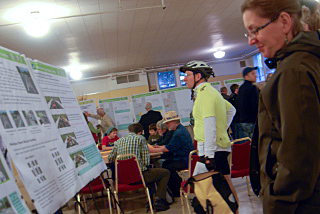
but said she often hesitates to bike
to visit a friend who lives near SE 40th Avenue,
because the current route feels like a hassle.
(Photos by M.Andersen/BikePortland)
Rich Newlands, the planner of one of the longest bikeway projects in Portland history, seemed relieved Thursday night for a chance to talk about something other than its most controversial 4,000 feet.
“It’s not all about the central section,” Newlands said, noting that the city faces a similar tradeoff between auto parking and comfortable biking between SE Gladstone and Steele, at its southern end, as well as a series of many route choices up the Alameda Ridge and across Killingsworth Street at its northern end.
Thursday’s open house on the 20s Bikeway, the first of three over the next week, was also a reminder that when bike access improvements can come without removing on-street auto parking or changing existing lane configurations, they’re almost totally uncontroversial.
“I can’t believe how fast people can go from Fremont to Klickitat — and with kids and pets,” said Denise Maki, 53, who lives near 26th and Fremont and called herself a “fair weather” biker. She said she had attended the meeting (which was held on the northern side of the future route) mostly because of a television report that had left her with the impression that parking would be removed from one side of the street all the way from NE Columbia to SE Steele.
Newlands and his colleagues were happy to inform her that auto parking north of Interstate 84 would be unaffected. Maki said she supports adding speed bumps to a north-south street in her area and that she’d “calm her neighbors.”
The major question facing the city for the northbound route is which of several neighborhood streets to take: 26th, 27th, 28th, 29th or 32nd. One key difference is that the corner of 32nd and Killingsworth is straighter than the others.
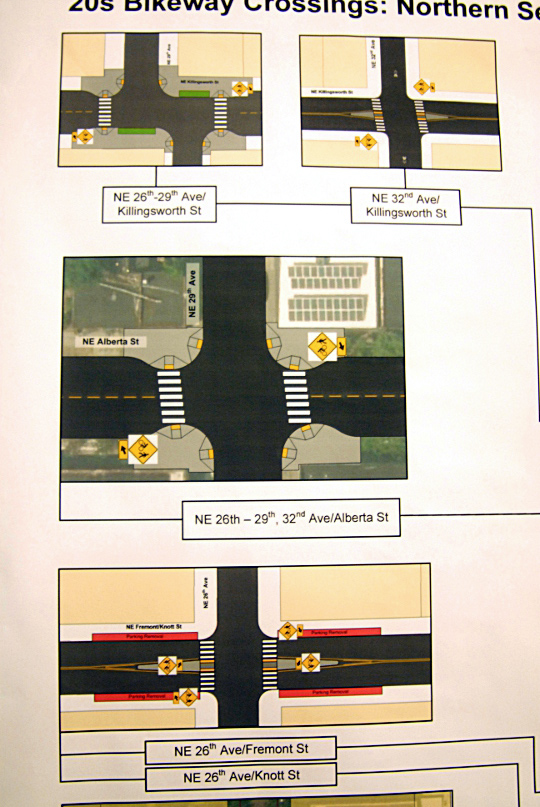
Jeff Walenta, 35, said he lives in the Buckman neighborhood and feels he has no good options for crossing major streets when he bikes north.
If that were his commute route, he said, “it would be when, not if, I would be hit” while crossing a big street, he said.
Another issue that Newlands wants to call attention to is the elbow of road between Powell Boulevard and Reed College. There, he said, the question for the city is whether to push for parking removal from one side of 26th Avenue between Gladstone and Steele in order to create a comfortable southbound buffered bike lane, which Newlands said would be a “great facility,” or to essentially give up on improving 26th, which south of Holgate is a commercial and light industrial street that gets regular truck traffic.
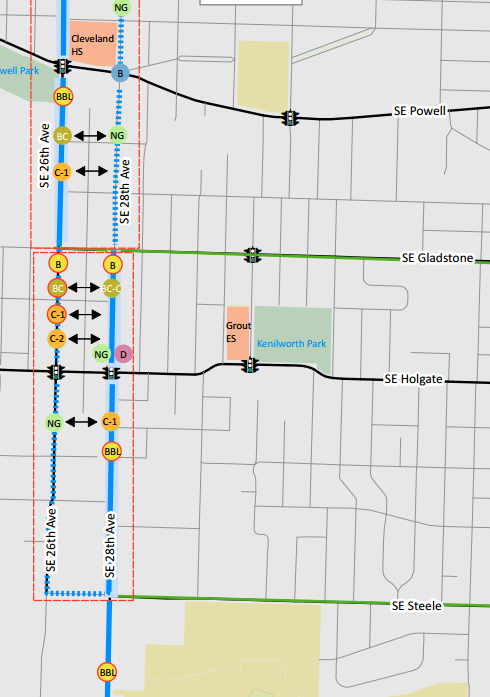
Newlands said his best guess is that the city would not add the buffered bike lane to 26th and would instead focus only on 28th, which (whether or not 26th is improved for biking) is slated to get speed bumps, sharrows and an entirely new traffic signal at Powell.
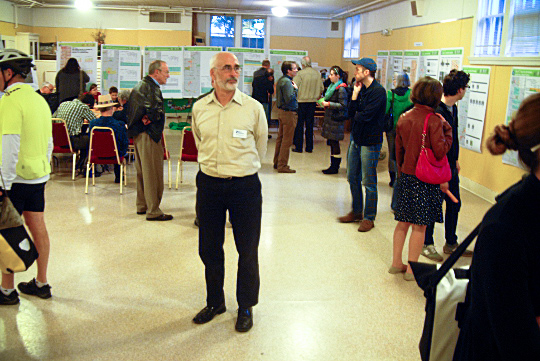
But even at Thursday’s event, many people wanted to talk about the most interesting part of the 20s Bikeway: the popular commercial district on 28th Avenue between Sandy Boulevard and Stark Street.
At issue is whether the city is best served by removing a lane of auto parking from the west side of 28th to add a southbound buffered bike lane and northbound green-backed sharrows, or whether it should attempt to route all bike traffic to the neighborhood greenway it intends to build on 30th.
Karen Mapes, 60, said she lives near the bikeway north of Interstate 84 and visits the commercial district regularly. “It doesn’t bother me if they take the parking out,” she said. “People will adjust.”
When she’s going somewhere parking is scarce, Mapes said, she’ll just take bicycle or transit instead. “I never drive downtown,” she said.
Heather Gramp, 44, lives in the Concordia neighborhood and said she’s a confident rider: not part of the so-called “interested but concerned” bikers that Portland says it designs its bikeways to serve.
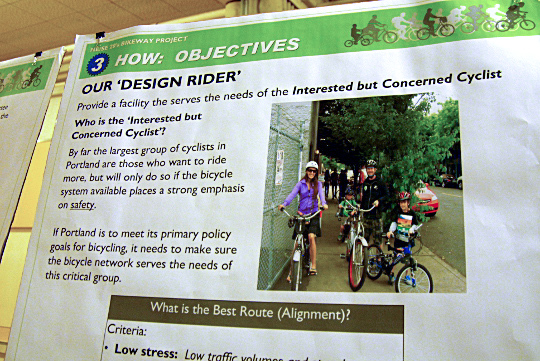
Gramp said her main interest is in improving pavement quality along bike routes. She said poor paving often deters her from using the neighborhood greenways along NE Going and NE Holman. But she also said the current state of 28th Avenue seems to have a psychological effect on her choices when she travels south.
“I have a friend who lives on SE 40th, and it’s always like, mmm, do I want to go over there?” she said.
Tom Huminski, 41, showed up Thursday with his son William, 4, who was wearing a Nutcase brand bike helmet.
“I would be fine with a buffered bike lane with my family,” Huminski said, looking at the city’s rendering for SE 28th. But rather than share a lane with cars or take any bike lanes that aren’t buffered, Huminski said, he’d probably take a side street, whether or not he was with his family.
“My MO whenever I’m in a situation like that is to go one street over,” he said. “Going Street right now, we like it. We ride it all the time.”
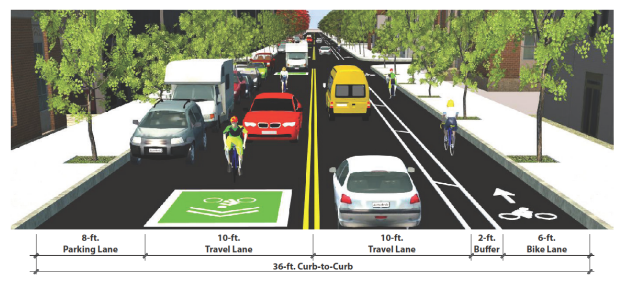
A few people at Thursday’s meeting seemed less interested in the details of the bikeway than in the general idea that the bikeway would impede auto traffic.
Jim Karlock, who said he lives a few blocks from the northern stretch of the bikeway, called the plan “sort of a de facto takeover of the streets” and said “it’s obviously past time for bikers to start paying road taxes.” He said removing auto parking, as on 28th or SE 26th, is “death for a business.”
Karlock compared the plans to a past sidewalk widening project along Sandy Boulevard, which he said was responsible for making Portland’s Hollywood District “not as thriving as it used to be” because it had constrained auto turns in order to make room for trees along the roadside.
Ray Splinter, 76, said he was also interested in licensing bicycles in order to raise money for bike-related projects. He added that “everybody needs to go back to school, bicyclists and motorists, to learn how to get along together.”
The city will hold two more open houses on the 20s Bikeway: one on Monday, March 17 near the southern section at Cleveland High School, 3400 SE 26th Avenue, and one on Tuesday, March 18 near the central section at Central Catholic High School, 2401 SE Stark. You can also share your opinion with project manager Rich Newlands by emailing rich.newlands@portlandoregon.gov.
More info on the 20s Bikeway Project:
– Past coverage on BikePortland
– PBOT’s official project page


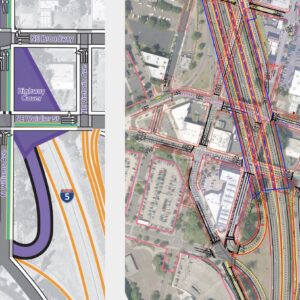
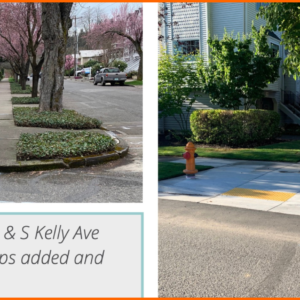
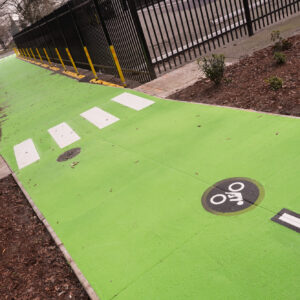
Thanks for reading.
BikePortland has served this community with independent community journalism since 2005. We rely on subscriptions from readers like you to survive. Your financial support is vital in keeping this valuable resource alive and well.
Please subscribe today to strengthen and expand our work.
“Karlock compared the plans to a past sidewalk widening project along Sandy Boulevard, which he said was responsible for making Portland’s Hollywood District “not as thriving as it used to be” because it had constrained auto turns in order to make room for trees along the roadside.”
That’s interesting, because having grown up in the Portland area I’d say Hollywood is making a big comeback from the state it was in about 10-15 years ago, and it’s undoubtedly due in big part to the more pleasant walking atmosphere and the trees.
Agreed. I used to commute via car with my parents to school/work through Hollywood and never would have stopped anywhere near there to grab a bite or hang out (10ish years ago). Now we go there whenever the parents are in town.
I agree with Kyle. I moved to Portland in 1996, and Hollywood was the first neighborhood I lived in. I would say that even before the fire next to the theater that took out that great Vietnamese bakery, Hollywood was definitely nowhere near as nice then as it is now.
Among other challenges, our closest grocery option at the time was Kienow’s (currently a QFC) – nearly a mile away – followed by the so-called “Hollywood” Fred Meyer, even further away and difficult to access from the east by bike or foot. Now you’ve got a Whole Foods, a Trader Joe’s and a Grocery Outlet — covering a pretty wide range of pricing options, there — all right in the neighborhood within walking distance of our former apartment. WOW!
Karlock is a well-known pro-car activist in this region. He has been banned from the Portland Transport blog several times. Probably best just to ignore his comments.
Michael, The fact that Karlock’s refusal to give an age was mentioned came off as somewhat ageist to me. (I disagree with Karlock on just about everything.)
Not my goal, certainly; I try to remember to ask for the age of every non-“official” person I talk to, as you can see above. But I’ll remove this reference above to avoid that appearance.
Thanks, Michael. It kind of struck me that way too.
I’ve begun wondering lately about the longstanding journalistic practice of identifying quoted sources by age. People of all ages can make naive, curmudgeonly, or intolerant statements (or wise, sound, thoughtful ones). I’d like to think my own pearl-clutching, little-old-ladyish comments speak for themselves, whether my name is suffixed with “28” or “88” (or, accurately, “58”).
Ha! I think it’s the single most space-efficient way to convey a little bit about who a person is, though not the whole picture for sure. Also, I think it’s a subtle cue to the reader that I’m quoting a person on the street rather than somebody they’re supposed to have heard of before. That’s why I’ve continued the practice since leaving newspapers.
I disagree. If he is older (say 60+) or younger (say 30-45) makes a difference to me at least. Seems like many of the most resistant people to change (and bike infrastructure) tend to be older.
Me too. Representing the ages of commenters is–I find–enlightening, whatever their ages.
Dave, it sounds like you’re feeding a bias you have against people over a certain age. For a while during the 60′ there was this pop culture phrase that was popular for awhile. Went something like: ‘Don’t trust anyone over 30’. Funny. Young conservative Republicans, as well as a lot of people that had already settled down and were trying to prepare for a stable future for their family, got a lot of attention. Didn’t like the idea that people not making as much money as they were, or expected to, would be getting a ‘free ride’, off of them.
Karlock is kind of a crank, but something that can be said of him, is that compared to many people, he’s articulate. Add to that, it seems he usually does at least some study to back up arguments he puts forward. Irrespective of his age, whether people agree with his views or not, this earns him a level of respect others wistfully wish they had.
Karlock though, does seem to like inflammatory rhetoric lacking in real substance. Remarks of his such as this one enclosed in this bikeportland story excerpt:
“…Jim Karlock, who said he lives a few blocks from the northern stretch of the bikeway, called the plan “sort of a de facto takeover of the streets”…”
Describing this plan as “sort of a de facto takeover of the streets” is just poor strategy that doesn’t really help improvements from the status quo. Same with his “death for a business.” remark about removing street parking on 28th or SE 26th. Especially since he lives in the neighborhood and is familiar with it, he could probably be able to help devise ideas for close by parking to replace the minimal parking that street parking provides.
Not knowing anything of his physical abilities, if he lives a half mile away from the community meeting location, I don’t begrudge his having driven to the meeting. Having to drive or be transported because, regardless of their age, they can’t walk the distance is a reality for many people. That this is being acknowledged and provided for by people planning this project, is something that should be very clearly stated. Doing so, will effectively deflate inflammatory rhetoric lacking in real substance.
My beef is more about covering Karlock at all. He’s become the Fred Phelps of bikephobia — a outlier who doesn’t accurately reflect normal people’s concerns. Sure, he’s full of hyperbolic soundbytes (“death for a business!”) but I’m sure there were people with more widely-held and reasonable concerns in that room.
I appreciate the feedback, Carl. I certainly don’t go out of my way to call Karlock up. In this case, the guy lives on 35th Avenue, he’d driven (!) the half-mile to his local open house, he was one of many residents I was quoting and he had strong, thoroughly informed opinions. I think his views were worth including.
Jim also thinks curb extensions serve not purpose.
He also has claimed that crosswalks and speed bumps make the roads more dangerous. He should be ignored.
What I’ve learned from my poli-sci polling and stats studies is that people don’t get inflexible or “curmudgeonly” as they add chronological age. They likely have been that way to a degree all along. It’s more of a generational thing. The dominant paradigm under which a person was raised. Some of the most liberal and progressive people I’ve known have been 80+. Some of the most hidebound, willfully ignorant folks I’ve known have been in their 20s. Personally I resent being stereotyped by age, gender orientation, skin shade, religion or none, etc. It is far too broad a stroke. I hope BP stops.
Really? You don’t think there is a general shift from liberal to more conservative as people age? I thought this was a pretty well believed idea.
“I would be fine with a buffered bike lane with my family,” Huminski said
Thanks for going to the open house and making that comment, Tom. My partner also is comfortable on buffered bike lanes but avoids conventional bike lanes.
I couldn’t make this meeting, so thanks for the excellent coverage. I’m happy to hear that there’s emphasis on the difficult arterial crossings: I’m personally fine with a route that shunts bikes to side streets–it’s how I ride north-south now. But getting across the big boulevards always feels like a crapshoot to me, and makes all my many north-south trips feel uncomfortable and less safe.
Short version: For me, safety and ease trump speed and storefront access.
The 20s south of Powell is my daily route. I NEVER ride 26th between Gladstone & Steele. Commercial traffic in this industrial neighborhood has a right to be there. 26th is ugly and uncomfortable. 28th, just a couple of blocks over is already aligned with the dogleg by Reed college, runs through a pleasant (enough) residential neighborhood and it is striped with good bike lanes in both directions. 28th is a much more desirable route.
A bike lane on 26th is a square peg in a round hole and tying into that little creek side, off street connector between 26th and 28th is not worth the unpleasantness of using 26th.
i have the opposite opinion of 26th. I ride this a few times every week and have rarely felt threatened, the road is VERY wide and even with cars parked on either side there is still a ton of space for everyone. It’s just much easier for me to get on 26th (where I’m going to have to eventually be to cross Powell). I’m definitely not alone as there are many car and bike commuters on this route.
26th in this area is “part” industrial. There are all kinds of new businesses on there now, like Gigantic Brewery and Naomi’s Farm Supply. I’m sure at LEAST these two business would like better bike access (not that it is that bad now).
Karlock’s suggestion that bikers pay road taxes, which we all know virtually all of us do already, seems to beg for the end of freeloading. Makes sense in this age of restricted resources. I’m sure he’ll be first in line to support parking meters with congestion pricing along 28th. And parking zone stickers on every other street. It’s time those people started paying for the services they receive.
Nice!
I do wonder when we can be done with this “it’s obviously past time for bikers to start paying road taxes” circus, once and for all? I have a feeling the BTA is not going to be taking any more runs at that one in the near future. Maybe a special series on bikeportland?
Let’s just impose a vehicle registration tax with a weight multiplier variable, since weight is the biggest determination of road damage. Let’s all pay $0.10 per year. I’ll gladly fork over $5 for each of my bikes, if Jim pays $400 per year for each car he owns.
What was Jim Karlock’s age?
attend an open house and find out. 😉
Not if he won’t tell me!
For those who hadn’t heard of him, like me (sorry), I found this……
http://bojack.org/2011/05/a_renegade_is_brought_to_justi.html
So the guess is 70
Glad to hear some discussion of the issues between Powell and Steele, since I now live in Brooklyn and I very frequently use or cross that corridor when traveling to Kenilworth and Creston Parks, Woodstock and destinations further east.
I would agree that in this area 26th would be difficult to salvage for safe biking, especially between Gladstone and Holgate, so it probably makes a lot more sense to focus resources on 28th.
Downside, at least to me personally, of doing nothing on 26th is that the Holgate sidewalk is the ONLY viable safe route to the east in and out of my Brooklyn neighborhood. And the connection between 26th and 28th is difficult, with narrow sidewalks, dedicated car-turning lanes and bad blind spots next to buildings. ANY improvement to connect 28th to the west with the sidewalks of the Holgate/Brooklyn Yard bridge would be immensely welcomed.
I should add that my trips through the 26th/28th/Gladstone/Holgate area are often with my kid and/or on my slow-moving cargo bike, making me extra conflict-averse. If I were just commuting through on my faster commute bike I might be a little more open to riding 26th. But I probably still wouldn’t take 26th unless I were in a really hurry.
Ray Splinter, 76, said he was also interested in licensing bicycles in order to raise money for bike-related projects. He added that “everybody needs to go back to school, bicyclists and motorists, to learn how to get along together.”
While we’re at it, let’s license everyone who leaves their home. I can’t wait to get my pedestrian license!
Still, having everyone review and retest for a license every 4 years would be a good idea, and it’s also a component of a Safe System/Vision Zero strategy.
i think this would help emphasize that operating heavy machinery in a city full of vulnerable traffic is a privilege — not a a right.
It’s very troubling how powerless PBOT feels about removing car parking. It’s public space, despite the historical progression where the space has been ‘traditionally’ given over for car storage.
The parking spaces in front of businesses or homes are in the public space, and those owners/residents really don’t have a legal say about how that space is used – except as a part of the broader citizen voice.
I really need to check in with some of my lawyer friends, as there seems to be a FUNDAMENTAL EQUITY PROBLEM here. As public space, we all own it, and yet a segment of the population [car owners] gets to use this resource free of charge.
Any lawyers want to chime in on this opinion??
Metered and permitted parking is better, but still the space should able to be considered for other uses for the public good [buffered bike lane, for example].
I suspect that a culture has grown at PBOT – who I love btw – to avoid screaming citizens who feel threatened with an appropriate allocation of public space. It would be sad if a posse of lawyers had to force the City to allocate public space such as the street for the broadest public good … I’d much prefer they came to this realization on their own.
“…The parking spaces in front of businesses or homes are in the public space, and those owners/residents really don’t have a legal say about how that space is used – except as a part of the broader citizen voice. …” Bill Stites
Legal say of businesses and homes is only part of what the city needs to consider in plans for changes to infrastructure. Accessibility and related economic vitality is part of what many people feel street parking plays an important role in helping sustain. The city should, and does want business to do well, so it naturally is going to listen to worries expressed by business owners, that their business will suffer if close parking goes away.
“it naturally is going to listen to worries expressed by business owners, that their business will suffer if close parking goes away.”
Given the range of opinions about the effect of this on business health, the city could listen but also then demand some evidence that the sky would fall from said businesses.
“…demand some evidence that the sky would fall from said businesses.”. 9watts
re; “…sky would fall from said businesses. …”. I don’t believe the type of extremist rhetoric you and Jim Karlock tend to use, characterizes worries that all, or even most businesses have expressed having about this plan. It’s this kind of extremist rhetoric that contributes towards driving people apart, rather then encouraging them to work together and support them in doing so.
The responsibility for providing evidence the plan will not cause business to suffer, belongs to the city, and people interested in making this change. Providing convincing evidence to them that the plan will not negatively affect their business, and very likely will instead, improve their business and the neighborhood, will bring them on board.
“The responsibility for providing evidence the plan will not cause business to suffer, belongs to the city, and people interested in making this change.”
How is that? We are not talking about razing buildings on private property, we’re talking about removing a few car parking spots in the public right of way. I don’t see how the onus is on the city to show anything related to the anticipated effect of doing that on the viability of the adjacent businesses, beyond something like the PSU studies which show the ratios of spending by customers according to their transport mode choice.
Dwaine Dibbly, 56, thinks that removing on-street parking is a reasonable way to improve our streets, but worries that the City’s strategy of endorsing apartment buildings with zero parking is only going to drive up demand for on-street parking and make it even harder to remove on-street parking in the future.
Free street parking is always in high demand in lively urban areas. Developers aren’t able to charge for parking to recoup the costs when there is plentiful free street parking available. If we actually started charging for the precious public street space devoted to inactive vehicles, I think there would be no problem as the market adjusts. People will demand private parking spaces with their units and pay developers to include them. Requiring ALL development to provide parking is inefficient, particularly for small multi-family buildings (30 units or less).
And building apartments with parking will enable more people with cars to move to the area, making it more difficult to create low-traffic streets for bikes, and convert. travel lane space on major arterials. Pick your poison.
The need for implementation of meter and permit districts in areas with constrained on-street parking supply is well-documented. The key is to improve transit service to the point where demand for off-street parking in new units is reduced, as people find that TriMet can better support a carfree lifestyle – something that it arguably cannot do today, given the lack of off-peak frequency or span of service, particularly evenings and weekends.
I’m very glad I made it out to this …I was encouraged by the amount of people that were at least receptive to the idea of removing parking…personally I think there needs to be permitted parking on some of this route and most of the folks who I talked to who live along say 28th didn’t seem to be against it
i wonder how many portland residents equal one “business stakeholder”.
50:1?
100:1?
200:1?
PLEASE tell me you at least rebutted him on this fallacy that “bikers” pay nothing for the roads and the implication that car users pay for it all (or even their fair portion). This perception has got to stop.
Same with this guy. Did you explain to him that nowhere in the history of people trying this has it even been able to cover the costs of implementing the program itself? I won’t disagree with him on the second point – most everyone could do well with a “back to school” on road rules and laws (but I wonder how he proposes covering that cost).
More development for inner NE/SE…ignore east of of 82nd. Repeat.
Seriously? Safe and efficient north-south bike access is a big problem throughout this entire city, not just the part of it where you live. I don’t even live on this side of the river and think improvements along the corridor are badly needed. I’m sorry if you feel like they wouldn’t help your day-to-day riding, but you are definitely in the minority here.
122nd would be really nice with raised cycle tracks on both sides. Of course, you would need to remove all parking and close some driveways to prevent conflicts. Do you think your neighbors and businesses would support it?
I regularly use Stark & 28th Streets to return home from the upper stretch of Belmont and in the last 2 years the only businesses that I have regularly frequented are Pod 28, Laurelhurst Theater & Crank.
As a rule I entirely avoid 28th from Ankeny on to Glisan/Sandy like the plague due to the aggressive drivers and massively constrained space for riding.
Honestly I think the last time I went to a business along that stretch was during Pedalpalooza in 2011.
Unless some MAJOR BIKE IMPROVEMENTS are made along that stretch I will continue to avoid the area entirely and use Ankeny instead.
And I consider myself a Strong & Fearless rider.
I felt like I understood the length of this stretch until seeing it taken as a whole.
Perspectives on SE 26th probably depend on time of day. When Gigantic opens up, business elsewhere is done for the day, and it looks like a quiet residential bypass for the most part.
Things get pretty snug north of Ankeny. I don’t need buffered lanes and less parking, I just don’t want cars breathing down my neck. What’s the commercial equivalent of a neighborhood greenway?
I agree that SE 26th truck traffic is too scary for riders with kids in tow. I rode my bike to a plumbing business on SE 26th to make a payment and definitely felt squeezed. I can’t recall how much of the route had a bike lane, but generally felt like a not-so-pleasant ride (except it was very nice weather that day).
However, this just goes to show how these bike routes are important to the whole region – I live several miles east of this corridor and still occasionally find the need to use it. Given that regional auto traffic tends to trump local desires on both state and local roads, why aren’t regional bike routes bumped to that same level of importance? Or have we stopped being the innovators?